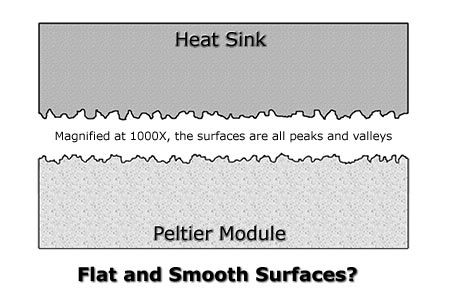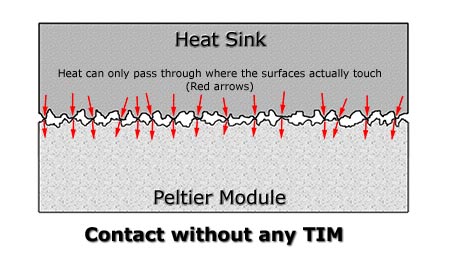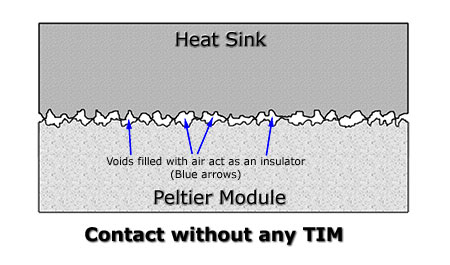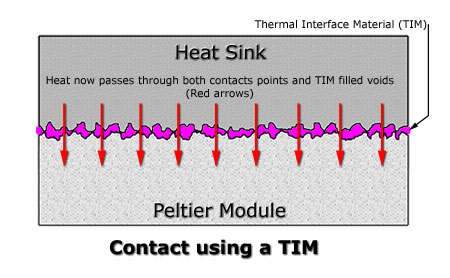Thermal Interfaces & TIMs
Thermal Interfaces and Thermal Interface Materials
A thermal Interface is any connection between two objects through which heat (thermal energy) must pass. A common example would be between a Peltier module and a heat sink.
Note: The terms Peltier module, thermoelectric device, thermoelectric module, TE cooler, TEC, Peltier chip, and Peltier junction are describing the same device and are used interchangeably.
The goal of a good thermal interface is to maximize the heat transfer of thermal energy. The following guide explains the problems with thermally joining two surfaces and offers several solutions to achieve this goal.
A Microscopic Look at Surfaces
Even when you have two “flat and smooth” surfaces, they are far from truly flat or smooth. The diagram below shows what’s really going on at a microscopic scale.

As you can see, the two surfaces may look flat and smooth, but in reality, when examined under magnification, they consist of “hills”, “peaks”, and “valleys”. When these two surfaces are brought into contact with one another, only the peaks make contact. It has been calculated that the average amount of contact between any two smooth surfaces is in reality only 5%. The other 95% are voids!


The above image shows how the remaining valleys create voids through which heat energy can barely pass through, in effect creating an insulated area – not the ideal thermal interface!
Surface Finish and Preparation
As a minimum, any surface intended to be part of a thermal interface should be flat to + - 0.001 inches over the entire interface surface and smooth to a surface finish of 32 micro inches or better.
If possible, a polished surface is better since it ultimately reduces the size and depth of the “peaks” and “valleys”. A polished surface finish of #6 to #8 is good, but the economics of polishing may determine a different stopping point for your product.
The interface surface must be thoroughly cleaned, once all machining and polishing is completed. Ultrasonic cleaning first in a heated degreaser solution and then in a solvent such as acetone is highly recommended to remove all oils and debris. (Never place a Peltier device in an ultrasonic cleaner!) Do not touch the surface with bare hands (skin oils) or allow any contact with other materials. It is better to complete this final cleaning stage just before assembly so as to minimize any dust or contamination.
Thermal Interface Materials (TIM)
A “third party” interface material is needed since it is all but impossible to achieve ideal flat and smooth surfaces. The purpose of the TIM is to fill the valleys and gaps with a compressible material that has a much higher thermal conductivity (ability to transfer heat) than the air gaps it replaces. This essentially makes the entire interface transfer heat instead of just where the peaks were contacting. The following image shows how the situation has been dramatically improved.

Types of Thermal Interface Materials (TIMs)
There are several common Interface Methods and their respective Thermal Interface Materials (TIMs). Many of the following TIMs can be found in the accessories section of this website.
Solders
Solders can be used between metals (if they are solderable) and on metallized Peltier module faces. See TEC Mounting Methods. Solder is a superior TIM since the thermal conductivity of most solders is around 30 to 60 W/m-K. In addition, solder is a mechanical mounting means that eliminates external fasteners. Care must be taken to avoid creating voids (air or flux pockets) within the solder. The most common solder is Sn63/Pb37 which has a thermal conductivity of 50.9 W/m-K and a eutectic melt point of 183°C. See our solder products here.
RT or NRT Liquid metals
Room Temperature and Near Room Temperature liquid metal alloys
These products are new on the market and so there is not much information on long term use and performance. They are primarily Gallium based metal alloys that are liquid (like Mercury) at or close to room temperature. Products such as Liquid Pro from www.coollaboratory.com have a thermal conductivity similar to that of liquid Gallium at 29 W/m-K. Unlike Mercury, it is also supposed to be non-toxic. It should be noted that gallium based products should never be used with aluminum, since it reacts corrosively.
Thermally Conductive Adhesives
The most common form of these adhesives is an epoxy base. They are typically filled with super fine particles of a thermally conductive material(s) such as aluminum oxide, boron nitride, aluminum, copper, and silver. Like solders, adhesives also serve as a mechanical mounting means. Adhesives also offer some advantages such as semi-flexible formulations that can handle CTE mismatch that arises from the joining of different materials. Typical thermal conductivities range from 1.5 W/m-K in the ceramic filled to 8 W/m-K in the silver filled versions. See our Arctic Silver Thermally conductive adhesives here.
Thermal Greases and Compounds
This is the most common form of TIM with literally thousands of products to choose from. There is a carrier liquid such as silicone (or other synthetic fluid) that is filled with micro fine particles of thermally conductive materials such as zinc oxide, aluminum oxide, boron nitride, or silver. Thermal conductivity ranges from 0.8 W/m-K to 7.5 W/m-K. See our Arctic Silver Thermal compounds and greases here.
Phase Change Materials (PCM)
When phase change materials are heated to a pre-determined transition temperature, the material significantly softens to a near liquid-like physical state in which the thermally conductive material slightly expands in volume. This volumetric expansion forces the material to flow into and replace the microscopic voids present in between the two surfaces. With the air gaps filled between the thermal surfaces, a high degree of wetting of the two surfaces minimizes the contact resistance. Many phase change materials are offered in pad or tape form which makes the application quick and easy. A major downside of phase change materials is that the product needs to be heated past the transition temperature (typically around 50°C) to initiate good thermal conductivity and sometimes the thermal conductivity can be significantly less below this transition temperature. Therefore, phase change TIMs may not be suitable for many applications where cooling temperatures are involved. Thermal conductivity ranges from 0.5 W/m-K to 4.0 W/m-K.
Thermal Sheets, Pads and Foils
Thermal sheets, pads and foils are appealing since application is quick and easy. In many cases, the materials are available either die cut to size or are easily cut to size with scissors and then simply applied.
Many thermal sheets are simply a substrate such as thin aluminum or copper foil with a thermal grease or compound applied to both sides in the optimum thickness. Thermal conductivities can therefore be expected to closely parallel those of the thermal grease or compound used on the substrate. These foil based sheets are the most economical and quickly installed TIMs and are often used in larger volume manufacturing due to the time savings without sacrifice of thermal conductivity. Kapton based versions are available if the TIM must be electrically insulating. Thermal conductivity ranges from 1.0 W/m-K to 8.0 W/m-K. See our Thermal Sheets here.
There are graphite based foils that are also available as a sheet and can easily be cut to size. This TIM requires a high compressive force to work effectively. A common complaint of these foils is that the graphite is non-elastic and therefore does not fill all the micro voids reliably over longer time periods. This is especially pronounced if there is significant thermal cycling involved. We typically use graphite foils for high temperature applications where other thermal compounds would not survive such as in our Thermoelectric Generator TEG products. Graphite foil TIM can be found here.
Silicone and other similar elastomers are available in a sheet form with ceramic particles and or fibers imbedded in them to increase the thermal conductivity. These are especially good for temporary assemblies or setups since TIM removal is simple and often reusable. There are also gap filling versions of these sheets such as those made by www.fujipoly.com. These TIMs require a moderate to high compressive force to work effectively. Thermal conductivity ranges from 0.5 W/m-K to 3.5 W/m-K.

